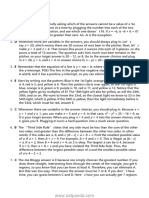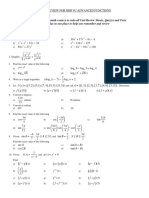Additive Counting Principle
Additive Counting Principle
Uploaded by
Oksana MandrykCopyright:
Available Formats
Additive Counting Principle
Additive Counting Principle
Uploaded by
Oksana MandrykCopyright
Available Formats
Share this document
Did you find this document useful?
Is this content inappropriate?
Copyright:
Available Formats
Additive Counting Principle
Additive Counting Principle
Uploaded by
Oksana MandrykCopyright:
Available Formats
Additive Counting Principle
We learned about the multiplicative counting principle, we are going to use this principle to find the
number of ways in which multiple outcomes can occur. The difference between the two is that the Additive
Counting Principle is used only interested in one of the tasks being accomplished not all of them.
For example, say you want to select two boys or two girls from a group of four boys and five girls. Notice
that, in order to perform this selection, you need one and only one of a list of sub-tasks to be accomplished,
that is, you need to select either two boys or two girls, not both.
Solution:
Since there is one and only one of a list of the sub-tasks we need to look at the way that the boys can be
chosen and the way that the girls can be chosen.
C(4, 2) = 6 ways and C(5, 2) = 10 ways, so the number of ways to select two select two boys or two girls is
6 + 10 = 16 ways.
Since the result that is being looked for is choosing two boys or two girls, but not at the same time, this is
called mutually exclusive events, we will look at this in more depth when we deal with probability.
Additive Counting Principle states that if the tasks are mutually exclusive and if the number of ways of
doing the first task is a, the second task, b, the third task, c, and so on, then the total number of ways to
perform one of those tasks is a + b + c +
Example 2:
A deck of playing cards has four aces and 12 face cards. From a deck of cards, how many can you choose
a) two aces or two face cards, when you pull two cards out?
b) one ace and one face card, when you pull two cards out?
You might also like
- AP Chemistry Workbook PDFDocument318 pagesAP Chemistry Workbook PDFOksana Mandryk100% (3)
- Mdm4uc 08 Assessment Solutions PDFDocument4 pagesMdm4uc 08 Assessment Solutions PDFYasin Khan100% (8)
- Static Electricity Worksheet 1Document1 pageStatic Electricity Worksheet 1Oksana MandrykNo ratings yet
- Discrete Math Module 4 1Document12 pagesDiscrete Math Module 4 1Leo AlolodNo ratings yet
- PEE - Lesson 4Document7 pagesPEE - Lesson 4Nathaniel NapayNo ratings yet
- Counting MethodsDocument9 pagesCounting MethodsRara Rizky FauziyahNo ratings yet
- Permutaion and CombinationDocument34 pagesPermutaion and CombinationAnupama NiroulaNo ratings yet
- Combinatorics and Probability Whole Name HiddenDocument17 pagesCombinatorics and Probability Whole Name Hiddenapi-255303924No ratings yet
- Math Perm and CombDocument88 pagesMath Perm and CombGurpreet VilkhooNo ratings yet
- Counting TechniquesDocument52 pagesCounting TechniquesPranav DessaiNo ratings yet
- Permutations Xi Xii Study MaterialsDocument44 pagesPermutations Xi Xii Study MaterialsKaran ChadhaNo ratings yet
- Lec 8Document8 pagesLec 8medo2012aldulaimiNo ratings yet
- Assignment No 2 Data AnalysisDocument18 pagesAssignment No 2 Data AnalysisBernadette PitogoNo ratings yet
- Permutations Combinations BasicsDocument41 pagesPermutations Combinations BasicsAnonymous q1gGEpNo ratings yet
- Combination Premed 2 2feb 2023Document72 pagesCombination Premed 2 2feb 2023sesaycom6No ratings yet
- Permutations and Combinations: Basic Principles of Counting Fundamental Principal of Counting Rule of ProductDocument19 pagesPermutations and Combinations: Basic Principles of Counting Fundamental Principal of Counting Rule of ProductVivek ReddyNo ratings yet
- Lecture 11 Fundamental Principle of Counting TechniquesDocument31 pagesLecture 11 Fundamental Principle of Counting TechniqueskairaisagaNo ratings yet
- CS Math ReviewerDocument84 pagesCS Math ReviewerJohn Rafael SordanNo ratings yet
- MMW Midterm Module 2Document18 pagesMMW Midterm Module 2Pie CanapiNo ratings yet
- Permutation CombinationDocument23 pagesPermutation CombinationUTKARSH TRIPATHI (RA1811004010394)100% (2)
- VTAMPS 14 P2 Set 1 FinDocument19 pagesVTAMPS 14 P2 Set 1 FinccpongolNo ratings yet
- Get The Full PictureDocument2 pagesGet The Full PictureSahil VermaNo ratings yet
- FullsetDocument110 pagesFullsetTristan LongNo ratings yet
- CBSE Class 5 Maths Chapter 6 Be My Multiple I'Ll Be Your Factor Revision NotesDocument11 pagesCBSE Class 5 Maths Chapter 6 Be My Multiple I'Ll Be Your Factor Revision NotesvarunsaisuriyaNo ratings yet
- Multinomial Coefficients ExercisesDocument11 pagesMultinomial Coefficients ExercisesKristine GaliciaNo ratings yet
- Grade Level 7 - Math Word ProblemsDocument7 pagesGrade Level 7 - Math Word ProblemsSonika MadanNo ratings yet
- Math Reviewer Season 2 SemisDocument9 pagesMath Reviewer Season 2 SemisGian Matheusz S. RoqueNo ratings yet
- How Many Possible Seating Arrangements Could Be Made If There Are 3 Chairs and Four Students?Document18 pagesHow Many Possible Seating Arrangements Could Be Made If There Are 3 Chairs and Four Students?xhingyeeNo ratings yet
- Module 4Document12 pagesModule 4Mohieddine FaridNo ratings yet
- How To Get The Greatest Common Factor of Numbers (GCF)Document12 pagesHow To Get The Greatest Common Factor of Numbers (GCF)MijiNo ratings yet
- Discrete Mathematics ForDocument65 pagesDiscrete Mathematics Forlijbelay7No ratings yet
- PPT8Document47 pagesPPT8clayorder147No ratings yet
- Business StatisticsDocument2 pagesBusiness StatisticsjustinatorNo ratings yet
- 8 Permutation & Combination Part 1 of 4Document5 pages8 Permutation & Combination Part 1 of 4Akhilesh Kumar MishraNo ratings yet
- Additive and Multiplicative PrinciplesDocument10 pagesAdditive and Multiplicative Principlesallauddinbaloch84No ratings yet
- Fundamental Counting PrincipleDocument5 pagesFundamental Counting PrincipleRhonna Joy MalabanaNo ratings yet
- RD Sharma Solutions For Class 11 Maths Chapter 16 PermutationsDocument39 pagesRD Sharma Solutions For Class 11 Maths Chapter 16 PermutationsTanmay JoshiNo ratings yet
- Sat Math Practice Test 7 AnswersDocument6 pagesSat Math Practice Test 7 Answerswwwmacy100% (1)
- Problem Solving StrategiesDocument6 pagesProblem Solving StrategiesJaselle NamuagNo ratings yet
- Web Solutions IMC2014finalDocument16 pagesWeb Solutions IMC2014finalTanhim HasanNo ratings yet
- PROBABILITYDocument44 pagesPROBABILITYRuel LaguitanNo ratings yet
- CAT PermutationDocument36 pagesCAT Permutationudhai170819No ratings yet
- Probability and Statistics: B Madhav Reddy Madhav.b@srmap - Edu.inDocument15 pagesProbability and Statistics: B Madhav Reddy Madhav.b@srmap - Edu.inSajan KumarNo ratings yet
- 3 - Order of Operations, GCF & LCMDocument16 pages3 - Order of Operations, GCF & LCMJessa Mae BanquirigNo ratings yet
- Permutation, CombinationDocument4 pagesPermutation, Combination221nicole0006No ratings yet
- Discrete Mathematics and CombinatoryDocument52 pagesDiscrete Mathematics and CombinatoryRemedan KelilNo ratings yet
- Lesson 3 ProbabilityDocument33 pagesLesson 3 ProbabilityBea Keanna BayaniNo ratings yet
- AptiDocument74 pagesAptiHimanshu ShuklaNo ratings yet
- Fourth Quarter Lesson 2 CombinationDocument27 pagesFourth Quarter Lesson 2 CombinationGilvert PanganibanNo ratings yet
- FUNDAMENTAL COUNTING PRINCIPLE: Multiplication RuleDocument2 pagesFUNDAMENTAL COUNTING PRINCIPLE: Multiplication Rulecatherine tucayNo ratings yet
- GMAT Quant Topic 8 - Probability SolutionsDocument19 pagesGMAT Quant Topic 8 - Probability SolutionsMantavya AgarwalNo ratings yet
- Combinations ProjectDocument10 pagesCombinations ProjectLeanne Dela Cruz100% (1)
- Chapter 1Document25 pagesChapter 1Firomsa MtNo ratings yet
- Lesson 5 Permutation and CombinationsDocument40 pagesLesson 5 Permutation and Combinationsgela tinNo ratings yet
- DPP Sol Jeeadv ProbDocument8 pagesDPP Sol Jeeadv Probyugantrajput12345No ratings yet
- MATH1081 Test 4 SolutionsDocument13 pagesMATH1081 Test 4 SolutionsIsha DeshmukhNo ratings yet
- ExcerptDocument10 pagesExcerptazamatdushanov999No ratings yet
- ProbablitlityDocument5 pagesProbablitlityBilal AhmadNo ratings yet
- Natural Log WorksheetDocument1 pageNatural Log WorksheetOksana Mandryk50% (4)
- Lesson Plan Course: Grade 12 U Advanced Functions Lesson: - 3 - 6 - Unit/Chapter: - Exponents - & Logarithms - Topic: Laws of LogarithmsDocument3 pagesLesson Plan Course: Grade 12 U Advanced Functions Lesson: - 3 - 6 - Unit/Chapter: - Exponents - & Logarithms - Topic: Laws of LogarithmsOksana MandrykNo ratings yet
- Mhfexamreview 2Document4 pagesMhfexamreview 2Oksana MandrykNo ratings yet
- Review From Grade 10 MathDocument5 pagesReview From Grade 10 MathOksana MandrykNo ratings yet
- Know Your Fire Extinguishers: NO NODocument1 pageKnow Your Fire Extinguishers: NO NOOksana MandrykNo ratings yet
- Moles and Formula MassDocument19 pagesMoles and Formula MassOksana MandrykNo ratings yet
- Lesson 6 Example ProblemsDocument9 pagesLesson 6 Example ProblemsOksana MandrykNo ratings yet




































































